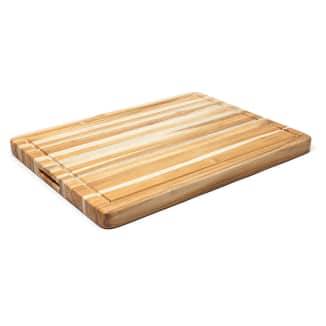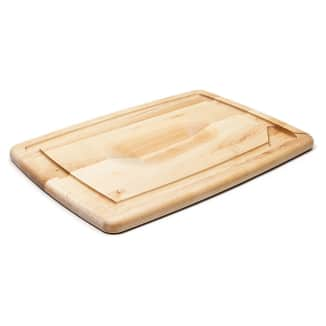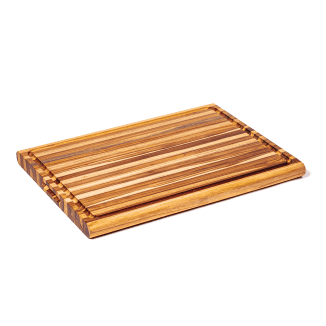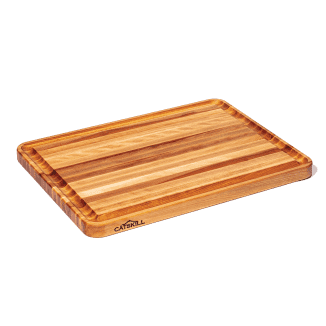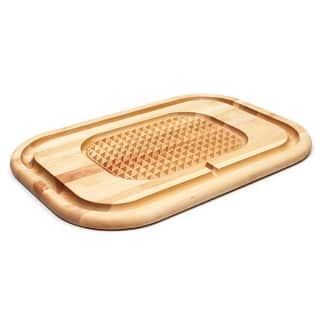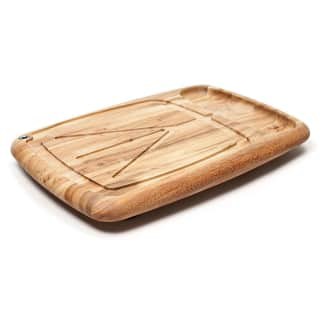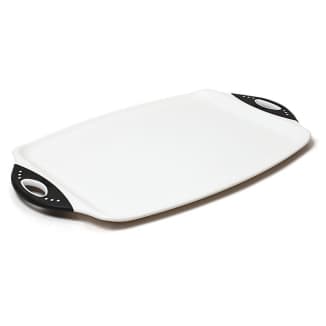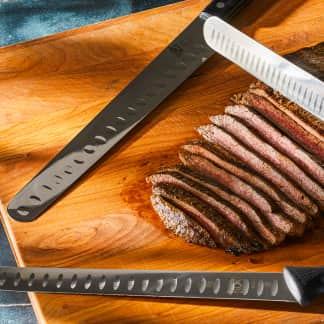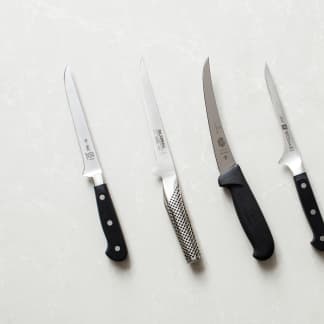The best carving boards make it easy to carve your holiday roast. Our longtime favorite is the JK Adams Maple Reversible Carving Board. It’s heavy enough to sit securely on the counter but still light enough to lift with a large cut of meat on it. It holds an impressive volume of liquid and features a poultry well that makes it especially easy to stabilize and carve a large turkey. If you’d like a carving board that can double as an everyday cutting board, we also recommend the Teakhaus Professional Carving Board with Juice Canal (L). It’s bigger and heavier than our top choice but still holds a fair volume of liquid.

Large wood or plastic cutting boards are kitchen workhorses. We use them every day and for pretty much every task. For these basic boards, we prefer models with completely flat surfaces. That’s because we’ve found that models with juice trenches—shallow grooves carved out around the perimeter of the board—are more of a nuisance than an advantage for most food prep, collecting stray bits of food and making the boards harder to clean.
But occasionally, a carving board—a cutting board with a dedicated juice trench or raised sides—comes in handy. There’s nothing worse than slicing into your perfect roast turkey or holiday roast and having its juices overflow your cutting board, dripping all over the counter and floor. A good carving board prevents this from happening, neatly draining the juices away from the roast and containing them in the trench so that they don’t make a mess. That way, you can funnel them back into your gravy or pan sauce.
What Size Carving Board Should I Get?
In general, we prefer boards that measure at least 20 by 15 inches, as we know from years of testing that this size can accommodate a large turkey with room to work. If you never plan to roast anything bigger than a chicken or slice more than a steak or two at a time, however, a smaller carving board might serve you just fine. Conversely, if you regularly cook lots of big cuts or roasts—20-pound turkeys, whole briskets, or several pork shoulders, for example—a larger cutting board measuring 24 by 15 inches is probably best for you. Just be aware that the bigger the board, the more it’s likely to weigh and the harder it can be to wrangle in and out of a sink for cleanup.

What’s the Best Material for a Carving Board?
We’ve tested carving boards made from wood, bamboo, plastic, and composite materials. We prefer models made from wood or bamboo, as plastic and composite boards are usually too thin to have the deep trenches needed to hold all the liquid that roasts can exude.
What to Look For
- Large-Capacity Juice Trenches: We preferred models with juice trenches that could hold at least half a cup of liquid, and more was better, since a really large turkey can release as much as a cup of liquid as it rests. The trench on one side of our top pick holds 5 ounces (slightly more than half a cup); the trench on the other holds 10 (slightly more than 1 cup)

- Big, Flat Surfaces: While a capacious juice trench is important, it shouldn’t cut into your usable cutting board space too much. The best carving boards gave us plenty of flat surface area to work with—at least 15 by 10 inches—big enough to break down a rib roast or slice a brisket. The flatness here was key, too, making it simple to slice and carve most cuts of meat.
- Moderate Weight: Most cutting boards need a certain amount of weight to help them stay put on the counter and prevent them from slipping around while you work. But carving boards can actually be a bit lighter than the wood cutting boards we often use. That’s because we commonly use carving boards under roasts or cuts of meat that are already pretty heavy. We prefer carving boards that weigh about 6 to 10 pounds, as we found them easier to carry and maneuver when laden with these heavy roasts. The roasts themselves also serve to weigh the boards down on the counter, so we never noticed any slippage.
Nice to Have
- A Poultry Well: Several models, including our top pick, came with concave wells designed to cradle and stabilize a chicken or turkey as you carve it. We loved this feature, as it made it particularly easy to carve even 20-pound turkeys. (We’ve also found it handy for keeping watermelons from rolling around as we cut them.) You’ll still be able to break down a chicken or turkey on a carving board that only has flat surfaces, though, making the well a useful but not essential feature.

What to Avoid
- Small-Capacity Juice Trenches: If a carving board can’t hold plenty of liquid, you might as well be using a plain cutting board.
- Textured Cutting Surfaces: We’ve tested a few carving boards with innovative textured surfaces. One had extra trenches grooved into the cutting surface to channel away liquid, and another had hundreds of carved pyramids meant to help secure your roast. While the trenches and pyramids worked as advertised, we ultimately can’t recommend either of these special features, as they impeded slicing and made it more likely that our knives would get damaged as we cut.

- Tray-Like Carving Boards: While the lone tray-shaped carving board we tested was able to hold a large volume of liquid, that liquid had nowhere to go, so food just sat in it. The raised sides of these models also made it harder to slice and cut food.
- Light Weight and No Stabilizing Features: Boards weighing less than 5 pounds and lacking rubbery feet or grips slipped around more while we were working.
Other Considerations
- Boards with Feet versus Reversible Boards: Carving boards with feet have a few advantages. Often tipped with grippy plastic or rubber, feet can help the boards stick to the counter, ensuring stable, secure carving even if the boards aren’t that heavy. Some testers also liked how easy these raised boards were to grab—they could just stick their hands in the space underneath them and lift. Feet also promote air flow, helping wood carving boards dry quickly. But many testers preferred boards without feet because they’re reversible, capable of being used on either side. Ultimately, one type isn’t necessarily better than the other, though our top picks are all boards without feet. The choice really depends on your personal preference.

- Combination Carving and Cutting Boards: Some boards had a trench on one side and were completely flat on the other, allowing them to be used as both a carving board and an everyday cutting board. As explained above, we generally prefer reversible boards with no trenches for daily use. And we’ve found that many boards with just one trench often hold less liquid overall. But for those who would like to have just one board for all tasks, we’ve designated a top carving/cutting board option, the Teakhaus Professional Carving Board with Juice Canal (L).
The Tests:
- Use to carve 20-pound turkey
- Use to slice brisket and roast beef
- Wash 25 times and maintain as needed
How We Rated:
Ease of Use: We rated the boards on how easy they were to lift, how well they contained liquids, how securely they held roasts, and how easy it was to cut different large foods on them.
Stability: We evaluated how securely the boards sat on the countertop.
Durability: We evaluated how resistant the boards were to scarring, cracking, separating, warping, and staining.
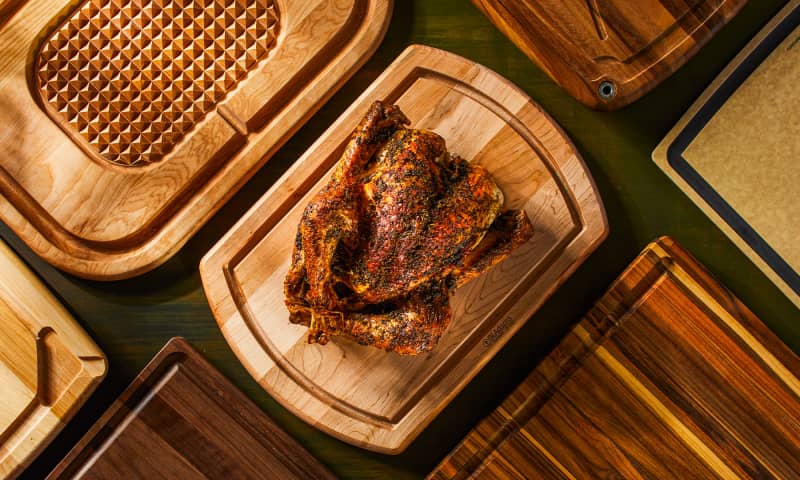
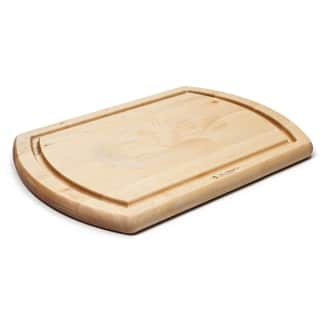
 Buy at J.K. Adams
Buy at J.K. Adams